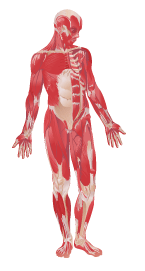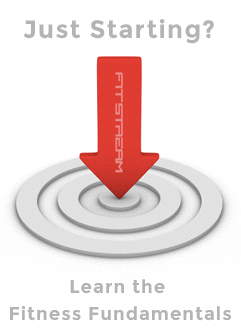Understanding muscle and how it responds to training is fundamental for improving performance and in devising more intelligent workouts to help build functional muscle.
Your body has around 650 muscles, even though most people only care about a handful. Our bodies are an integrated unit, a vessel that works seamlessly and largely unconsciously for co-ordinated movement.
Simply walking across the room will involve 200 or so muscles, and there are few words that can do justice to the magnificence of co-ordinated muscles in motion.
This article considers the basics of human muscle, how to build a strong, lean body and is summed up with muscle building tips. Our focus is on achieving this without it being at the expense of agility, power or strength.

Muscle Science
Knowing the basics of muscle mechanics can help give you that extra edge and insight into what's going on under the skin when you're training.
Your skeletal muscles are made up of two main types of fibre; Type-I, also known as 'slow-twitch' and Type-II, or 'fast-twitch'. Type-I muscle fibres are used mainly for endurance activities whereas Type-II begin to work when an activity uses more than 25% of your maximum strength.
An exercise doesn't have to be 'fast' or 'slow' to use a certain type of muscle fibre. For example, a personal-record squat is going to use as much fast-twitch fibre as possible even though the movement isn't necessarily fast.
There are two basic principles of physiology to get your head around:
- All or nothing - a muscle fibre either fires or it doesn't, there's no middle ground. So, even with a warm-up stretch, a small percentage of your muscle fibres are working as hard as they possibly can whereas other fibres remain completely inactive.
- Size matters - the smallest muscle fibres fire first and if the movement requires it, the Type-II fast-twitch fibres will be called into action. The closer you are to the limits of your strength the more fast-twitch fibres get involved.
So what do these rules mean to you and your training?
Simply training with light weights for extended sets and exhausting the muscle doesn't mean that you're training all the muscle fibres. The size principle means that the fast-twitch fibres are only used when your strength levels are really pushed. Meaning that for someone who is trying to build muscle you must lift heavy, close to all-out-effort.
Muscle and Genetics
The quantity of your muscle fibres is set at birth, but the quality of those fibres is up to you.
There's no escaping genetics and we're all bound by our genetic potential, but we owe it to ourselves to strive to reach this potential. Our genetics determine the following:
- Our maximum number of muscle fibres
- Our percentage of fast and slow-twitch fibres
- The shape of our muscles when fully developed
Training to Build Muscle
Here we outline how you should structure your training in order to build functional muscle and burn fat.

To maximise the development of lean, functional muscle you should incorporate brief, high-intensity, heavy lifting sessions into your training regime. Select big Olympic lifts like the deadlift, clean, snatch, and squat for an athletic physique that not only looks great but possesses strength, speed and power.
Choosing the right exercises is essential. Olympic lifts are multi-joint, complex movements challenging the body as an integrated unit and enhance athletic performance.
- Aim for 1-3 intense weightlifting sessions per week for 10-60 minutes at a time.
Muscles and Cardio
Prolonged medium-to-high intensity cardiovascular training will develop endurance levels and your ability to run marathons but will compromise muscle-mass, speed and power.
To maintain and actually build muscle through your 'cardio' training it's far better to workout using short, intense training sessions. Anaerobic conditioning via sprints or interval training is an excellent choice for burning fat without negatively affecting other areas of your fitness.
Muscle Building Tips
We've summarised the tips noted throughout this guide below for your reference:
- To grow large, you must lift large.
- Use functional exercises that employ the most muscle mass, such as squats, deadlifts, pull-ups and dips.
- Aim for 1-3 short, intense Olympic strength workouts per week.
- When incorporating cardio workouts use anaerobic interval or sprint training to build muscle and burn fat.










